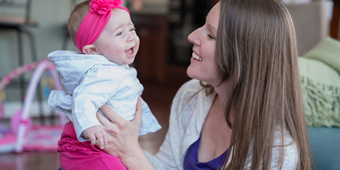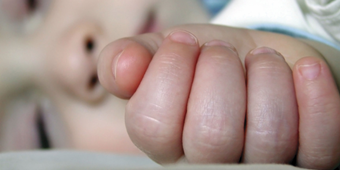Baby’s Sitting Up and Growing Up

Find Your Perfect Match
Answer a few questions and we'll provide you with a list of primary care providers that best fit your needs.
Once your baby begins to sit up unassisted, it won’t be long before it’s Go, Baby, Go! This important milestone prepares the way for babies to learn to crawl, walk and lead active lives.
You may wonder how to help your little one develop motor skills for sitting. You can play a key role in your baby’s developing motor skills. But keep in mind, every baby is different, and yours will let you know when it’s time to start sitting up.
Just like adults, babies need lots of practice to learn a new skill.
3- to 6-Month Milestone: Sitting with Support
Typically babies who are between 3 and 6 months old can sit with your support. Your help can include:
- During tummy time, help her push up on her arms and hands.
- Support her gently in sitting with your hands or body and engage her in play
- Help her use her hands to prop herself up when supporting her in sitting
- Use pillows designed specifically to support baby when she’s not being held. They can help to prevent injury from falling straight backward. Don’t use baby seats, which can actually hinder the development of sitting skills.
- Support her gently with your hands or body
7-Month Milestone: Sitting Up

Sitting up is tough work! It takes muscle development in the neck, upper body and back. By the time babies are 7 months old, they usually are beginning to have the strength they need to be able to sit without support. But stay close! After a few minutes, your baby might lose her balance and topple over.
8- to 9-Month Milestone: Sitting without Tipping
Typically, by 8 months, a baby will learn to sit without support. Better yet, if she starts to topple over, she will have the coordination she needs to catch herself. She will even begin reaching all around for toys.
Remember, every baby is different, and the ability to sit unassisted might come as late as 9 months.
How to Help Baby Sit Safely
When your baby is practicing sitting, place her on a blanket or soft activity map. That way, if she tumbles, she will have a soft place to land. When placing her on the mat, help her to lean forward instead of backward. Stay nearby to catch her, especially if she tumbles backward.
How to Help Baby Succeed at Sitting
Just like adults, babies need lots of practice to learn a new skill. Here are a few activities to help your baby develop strong muscles:
- Make tummy time fun time: Help your baby exercise by laying her on her tummy (while she is awake) and encouraging her to reach for toys. Make it a goal to do about an hour of tummy time each day. Keep it interesting by offering a variety of options: on your lap, on your chest, in your arms, etc. Keep in mind this will happen in three- to five-minute increments throughout the day.
- Get arms in on the action: You can help your baby get into the seated position. While your baby is lying on her back, take both arms and gently pull her into a seated position. You should see your baby start to use their own belly, neck and arm muscles to help you.
- Take a stroll: Having your baby sit in a supportive stroller can help her develop muscles for sitting on her own as she notices all the neighborhood sights.
- Experiment with what baby likes: Does she like music? Try holding her hands and swaying to the rhythm. Do you have a little athlete on your hands? Try playing “catch” by rolling the ball to her while you are both sitting.
- Carry in different positions: Don’t always hold your baby in the exact same position. By carrying her so she is cradled, facing outward, on your hip or laying on her belly in your arms, you will help to strengthen a variety of muscles that will help her learn to sit.
Find Your Perfect Match
Answer a few questions and we'll provide you with a list of primary care providers that best fit your needs.
Source: American Academy of Pediatrics; Centers for Disease Control and Prevention; What to Expect.com




